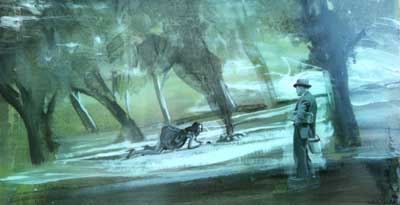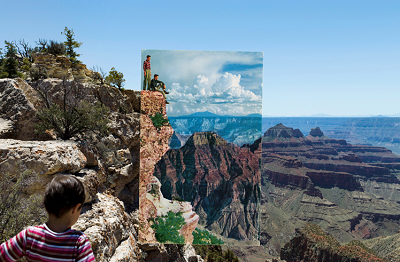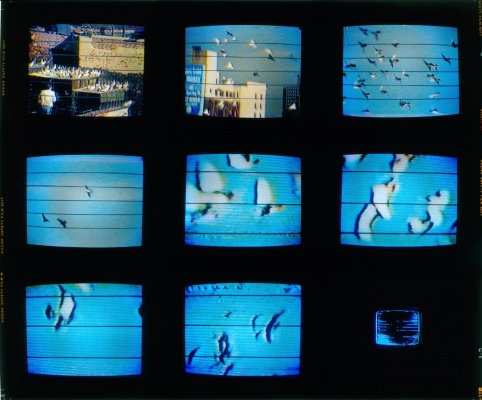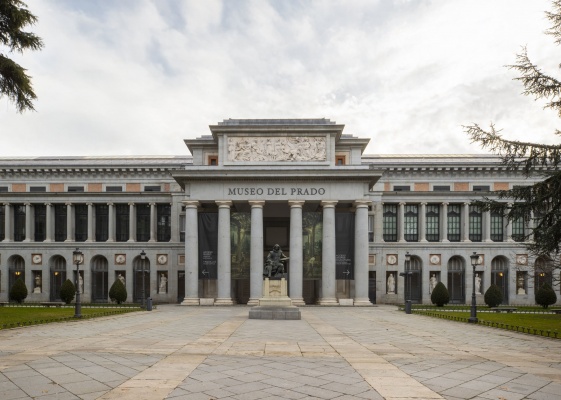Descripción de la Exposición ------------------------------------------------------- ------------------------------------------------------- At the beginning of his career, Jackson Pollock (1912 -1956) was open to a wide variety of influences. He went through a lengthy development until he arrived at his famous drip technique. As an art student in New York, he was influenced by his teacher Thomas Hart Benton, a regionalist who painted naturalistically. Benton's teaching as well as the influence of Pablo Picasso, the cubists and the Mexican muralist Orozco all marked the initially figurative art of Jackson Pollock. After 1936, he was also inspired by Native American art, with its symbolic forms, bright colors, and interlocking patterns. Only in 1946 did Jackson Pollock turn away from figurative painting. He wanted to reflect the artist's interior world, i.e., his interior world: 'I want to express my feelings rather than illustrate them.' Pollock developed the drip technique, letting paint drip and flow onto the canvas lying on the floor, he poured, exploded, and smeared, so that structures and patterns emerged from paint drips and rivers. With this technique of action painting, Pollock made art history, and it marks a turning point in the artistic development of North America, detached from Europe. He became one of the pioneering American modern artists. Pollock's paintings derive their power from contrasts, thus giving expression to the opposition of body and soul. He created labyrinthine network structures of paint linking gestural intensity with formal rigor. The production process of the work of art is in the foreground, the painting becomes a record of a dynamic process. In 1950, his style once again changed: Pollock created large compositions in black and white and covered white canvases with brown and black lines of paint going in all directions. In that year, the photographer Hans Namuth, an émigré from Germany, photographed the artist in his studio and also produced a film. The photographs, published in the following year in the magazine Life, caused a sensation and gave birth to Pollock the legend. After 1951, Pollock was much less productive, and at the end of 1954 he gave up painting altogether. On August 11, 1956, Jackson Pollock died after an accident he caused while driving under the influence of alcohol. January 28, 2012 is the 100th anniversary of Jackson Pollock's birth, and thus we will start the new year with a homage to this artist. Our exhibition There is no end - A Tribute to Jackson Pollock brings together different positions of five young artists - figurative as well as abstract works, video -, all of which relate to an aspect in the life and work of Pollock. Selket Chlupka chose as her reference point to Jackson Pollock the artistic work process. She is interested in the tension between control/intention on the one hand, and the role of chance on the other, and in the potential to consciously expand the possibilities of controlling that which emerges seemingly unintentionally, and thus perhaps manipulate chance in this way. Yago Hortal interprets Pollock's all-over extensively and literally has his paintings, which are usually explosive anyway, spill over. The bright paints seem to melt, flow, they tower like the icing or cream on a colorful gateau. We might almost call these works paint installations or paint sculptures. Wolfgang Neumann has never shown any respect for sacred cows. On his Leaker, the mythical figure Pollock does not hold a brush, rather, paint pours like blood from his arteries and veins, and in his palms he has the Lord's stigmata. Neumann outfits Lee Krasner, Pollock's wife sitting on a stool, with the same hairstyle as Marge Simpson, thus including her into the family of American icons. And as private joke, the artist has snuck a variant of his own painting Energy Drunk onto the wall of Pollock's studio. The connection between Pollock's pioneering drip paintings and Tim Plamper's video lies in Plamper's rhythmic composition of recurring motifs that together form an optical-acoustic arrangement; superimpositions of different but equal layers form a sound-image texture, just like in Pollock's abstract paintings, where the different layers of paint form intricate patterns and labyrinthine, entwined, seemingly vibrating structures. Fernando M. Romero has engaged with the gestural element in Pollock's work. In order to capture the gestural, he sampled Pollock's abstract patterns, placed them side by side as visual information, and subjected some of them to a process of warping or distortion. And we can clearly see that he has also dealt with the theme of the spatial on an abstract painting, an artistic problem for which he has found fascinating solutions.
Artistas: Selket Chlupka, Yago Hortal, Wolfgang Neumann, Tim Plamper y Fernando M. Romero.

Mercado, 15 feb de 2012
Las galerías presentan nuevos artistas en las ferias de Madrid
Por ARTEINFORMADO
Al menos 16 artistas expondrán sus trabajos por primera vez en los stands de sus nuevas galerías españolas que acuden a las ferias ARCOmadrid y JustMadrid, según la información facilitada ...

Mercado, 09 feb de 2012
Soskine, Tagomago, Silió y Siboney, entre los espacios que incorporan artistas
Por ARTEINFORMADO
Entre la quincena de nuevas incorporaciones y colaboraciones registradas por ARTEINFORMADO esta semana, hay que destacar en primer lugar la del artista cubano Abel Barroso (Pinar del Río, 1971) en ...

Exposición. 08 may de 2025 - 14 sep de 2025 / MNAC - Museu Nacional d'Art de Catalunya / Barcelona, España

Formación. 30 oct de 2025 - 11 jun de 2026 / Museo Nacional del Prado / Madrid, España